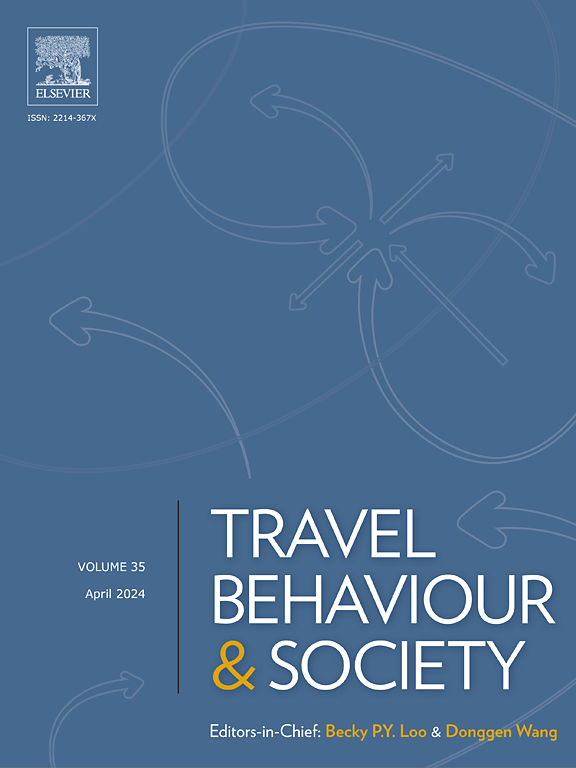将基于虚拟现实的眼动追踪与城市数字孪生相结合,揭示行人在寻路任务中的视觉注意力
IF 5.7
2区 工程技术
Q1 TRANSPORTATION
引用次数: 0
摘要
城市导航在很大程度上依赖于标志,然而在复杂环境中行人与这些线索的视觉交互尚未完全量化。本研究开发了一个沉浸式虚拟现实平台,将眼动追踪与基于摄影测量的详细3D模型集成在一起,该模型可以捕捉真实世界的几何和纹理特征,以研究凝视行为和视觉注意力,从而为导视标牌设计提供支持。提出了一种从眼动追踪数据中提取被试注视行为和估计视觉注意的方法框架。利用这种综合方法,设计了VR实验来研究行人在不同标识信息密度和不同任务条件下的凝视行为。采用结合XGBoost和SHAP的可解释机器学习方法来建模和解释距离、入射角、俯仰角和符号大小等几何特征如何影响特定的凝视行为,区分聚焦和扫描动作。结果表明,高信息标识提高了寻路效率,但可能增加认知负荷。在标识设计中,凝视距离和入射角是影响注意力的关键因素,呈现非线性效应和任务依赖阈值,距离小于30 m,入射角小于46°,俯仰角小于4.2°与视觉注意力增加相关。基于观察到的注意机制,根据任务语境提出了两种推荐的标识设计策略。该研究展示了VR和数字孪生技术在分析视觉行为方面的应用,为情境感知的城市标牌设计提供了基于证据的见解。本文章由计算机程序翻译,如有差异,请以英文原文为准。
Integrating Virtual Reality-based eye-tracking with urban digital twin for unveiling pedestrian visual attention in wayfinding tasks
Urban navigation relies heavily on signage, yet pedestrian visual interaction with these cues in complex environments is not yet fully quantified. This study developed an immersive Virtual Reality platform integrating eye-tracking with a detailed, photogrammetry-based 3D model that captures real-world geometric and textural features to investigate the gazing behavior and visual attention to support wayfinding signage design. A methodological framework is proposed to extract participants’ gazing behavior and estimate visual attention from eye-tracking data. Leveraging this integrated methodology, VR experiments were then designed to investigate pedestrian gaze behavior under varying signage information densities and different task conditions. An explainable machine learning approach combining XGBoost and SHAP was employed to model and interpret how geometric features like distance, incidence angle, pitch, and sign size influence specific gaze behaviors, distinguishing between focusing and scanning actions. Results revealed that high-information signage enhanced wayfinding efficiency but may increase cognitive load. For sign design, gaze distance and incidence angle were identified as key factors influencing attention, exhibiting non-linear effects and task-dependent thresholds, with distance below 30 m, incidence angle below 46°, and pitch angle below 4.2°associated with increased visual attention. Based on the attentional mechanisms observed, two recommended sign design strategies were proposed according to the task context. The study demonstrates the application of VR and digital twin technology for analyzing visual behavior, providing evidence-based insights for context-aware urban signage design.
求助全文
通过发布文献求助,成功后即可免费获取论文全文。
去求助
来源期刊

Travel Behaviour and Society
TRANSPORTATION-
CiteScore
9.80
自引率
7.70%
发文量
109
期刊介绍:
Travel Behaviour and Society is an interdisciplinary journal publishing high-quality original papers which report leading edge research in theories, methodologies and applications concerning transportation issues and challenges which involve the social and spatial dimensions. In particular, it provides a discussion forum for major research in travel behaviour, transportation infrastructure, transportation and environmental issues, mobility and social sustainability, transportation geographic information systems (TGIS), transportation and quality of life, transportation data collection and analysis, etc.
 求助内容:
求助内容: 应助结果提醒方式:
应助结果提醒方式:


